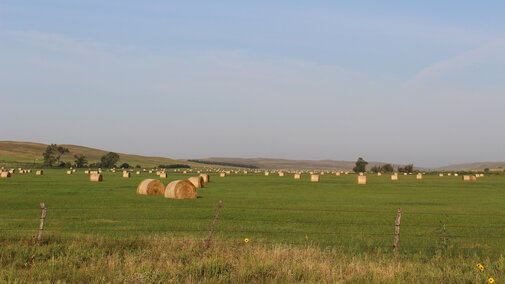Small Grain Hay or Silage Harvesting
Cooler temperatures have slowed spring pasture growth, delayed crop planting and limited cover crop production. So, cattle producers needing forage may consider harvesting small grains such as wheat, rye, triticale and oats as hay or silage.
When deciding timing and how to harvest, begin with the end in mind; noting that spring drying of windrowed forage can be a challenge. For young growing cattle, small grain hay should be cut in the boot stage or as soon as possible after heading to ensure higher protein and energy content. Awnless (beardless) varieties are preferred if harvest is delayed past the full heading stage. Mature cow and feedlot managers may consider delaying their forage harvest until the dough development stage to increase forage quantity since these cattle can utilize lower quality forage than younger beef animals.
In Nebraska Extension forage harvest studies, wheat and rye yields almost double by delaying spring harvest just one month. Compared to early May (boot stage) harvest, early June (soft dough growth stage development) irrigated biomass yields on average increase from 12 tons per acre to 20 tons per acre. However, the trade-off for delaying forage harvest is that forage crude protein content decreases proportionally dropping from 18% at the boot stage to 10% crude protein at the dough kernel grain stage. Another downside to delayed small grain forage harvest is shortening the growing season for double-crop annual forages planting such as corn or sudangrass intended for fall silage.
When small grains are chopped for silage (also termed wheatlage or ryelage), there may be opportunity for adding a week onto the subsequent annual crop growing season. However, if silage is your harvest choice, moisture content is critical, and the target moisture content for successful ensiling is 70-72% for proper packing. Generally, small grains have a 76-78% moisture content during the soft-dough grain stage and moisture drops 5% during harvest.
Still Time to Fertilize Summer Hay Meadows
Do you need to grow more hay for next winter? One way to get that extra hay might be to fertilize your hay meadow this spring. There may still be time.
Hay meadows respond well to fertilizer but be sure to use the types and amounts of fertilizer that work best for the plants in your hay meadow. For example, do you have much clover or other legumes in your hay meadow? Then fertilize with phosphorus. A soil test can tell you how much phosphorus to use — usually 20 to 40 pounds per acre will stimulate legume growth nicely in most hay meadows. These legumes then will help supply some nitrogen to the grasses in your meadow, and the hay you cut from this meadow will yield more and contain more protein than straight grass hay.
Maybe your meadow already is green and growing well with cool-season grasses like bluegrass, brome, timothy or wheatgrasses that head out in late May or June. Nitrogen can increase yield from this meadow. Warmer parts of the state may have already missed this window, but if your grass is still vegetative, there may still be time. The rate to apply declines as we go from east to west — use about 80 pounds of nitrogen per acre in eastern Nebraska but only 30 to 40 pounds in the Panhandle. Regions where rainfall has been lacking may hold off on fertilizing, as the added nutrients won’t be used without moisture for grass growth.
Warm-season grass meadows are starting to green up, too. Like cool-season grasses, nitrogen rates decline from 60 pounds in eastern Nebraska to 30 pounds out west. But be patient. Do not fertilize quite yet. Wait until mid- to late May before fertilizing your warm-season grass meadows.
Selecting Summer Annual Forages
Are you planning to plant a summer annual grass, maybe to build hay supply or have some extra grazing? Which one will you plant?
It can be confusing because there are six different types of major summer annual forage grasses. These include: sudangrass, sorghum-sudan hybrids, forage sorghum (which we often call cane or sorgo), foxtail millet, pearl millet and teff. Each one has its own strengths and weaknesses. So, base your choice primarily on how you plan to use it.
For example, do you want pasture? Then use sudangrass or pearl millet. Both are leafy, regrow rapidly and contain less danger from prussic acid poisoning than other annual grasses.
What if you want hay or green chop? Then select sorghum-sudan hybrids or pearl millet because they yield well and they have good feed value when cut two or three times. On sandy soils or when conditions are dry, foxtail millet may be a better choice for summer hay. It dries fast, doesn't regrow after cutting and handles dry soils well. Cane hay is grown in many areas and produces high tonnage, but it’s lower in feed value and dries more slowly after cutting than the hybrids or millets. Or you could choose teff for a really soft, leafy, high quality horse hay.
Maybe you plan to chop silage. Then choose the forage sorghums, especially hybrids with high grain production. They can't be beat for tonnage or for feed value.
While there are several choices of summer annual forages, simply select the one that is best adapted to the way you plan to use it. And, of course, hope for rain since even these grasses won’t grow without some moisture.

